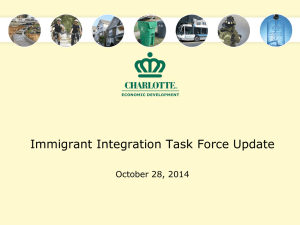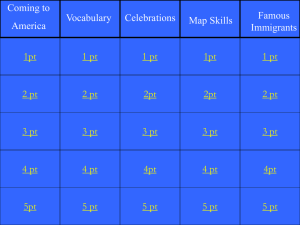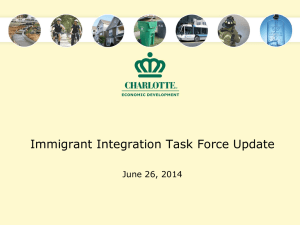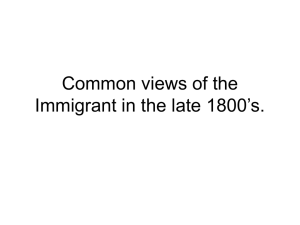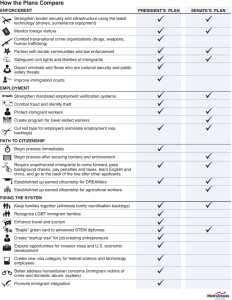SubgrantNarrative
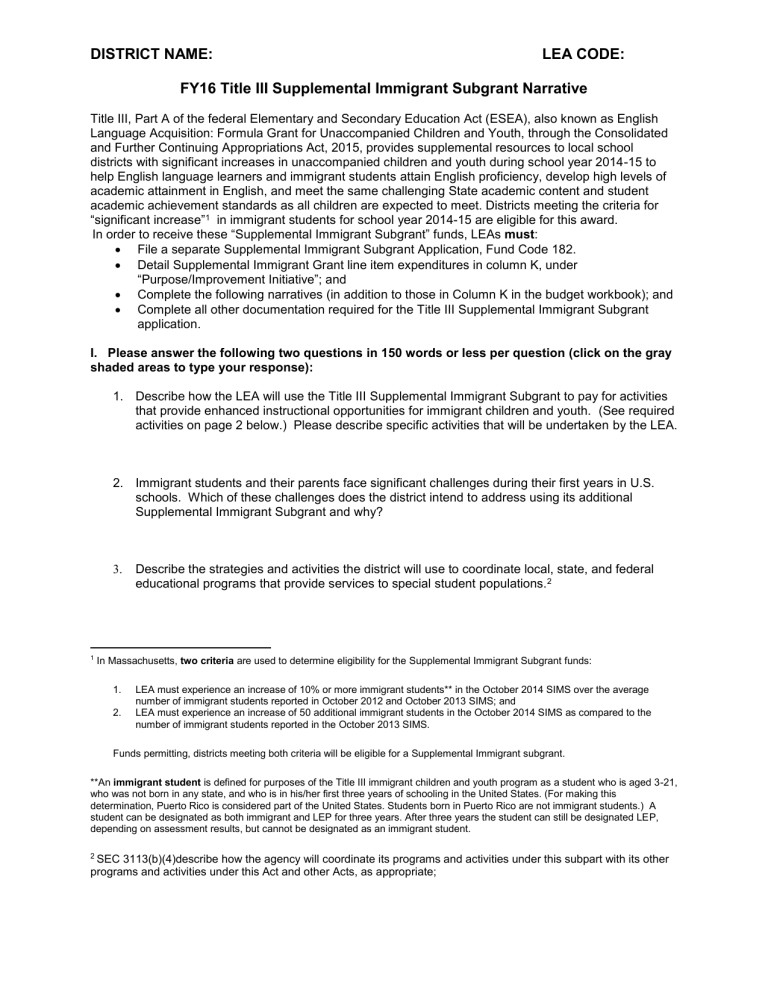
DISTRICT NAME: LEA CODE:
FY16 Title III Supplemental Immigrant Subgrant Narrative
Title III, Part A of the federal Elementary and Secondary Education Act (ESEA), also known as English
Language Acquisition: Formula Grant for Unaccompanied Children and Youth, through the Consolidated and Further Continuing Appropriations Act, 2015, provides supplemental resources to local school districts with significant increases in unaccompanied children and youth during school year 2014-15 to help English language learners and immigrant students attain English proficiency, develop high levels of academic attainment in English, and meet the same challenging State academic content and student academic achievement standards as all children are expected to meet. Districts meeting the criteria for
“significant increase” 1 in immigrant students for school year 2014-15 are eligible for this award.
In order to receive these “Supplemental Immigrant Subgrant” funds, LEAs must :
File a separate Supplemental Immigrant Subgrant Application, Fund Code 182.
Detail Supplemental Immigrant Grant line item expenditures in column K, under
“Purpose/Improvement Initiative”; and
Complete the following narratives (in addition to those in Column K in the budget workbook); and
Complete all other documentation required for the Title III Supplemental Immigrant Subgrant application.
I. Please answer the following two questions in 150 words or less per question (click on the gray shaded areas to type your response):
1. Describe how the LEA will use the Title III Supplemental Immigrant Subgrant to pay for activities that provide enhanced instructional opportunities for immigrant children and youth. (See required activities on page 2 below.) Please describe specific activities that will be undertaken by the LEA.
2. Immigrant students and their parents face significant challenges during their first years in U.S. schools. Which of these challenges does the district intend to address using its additional
Supplemental Immigrant Subgrant and why?
3.
Describe the strategies and activities the district will use to coordinate local, state, and federal educational programs that provide services to special student populations.
2
1
In Massachusetts, two criteria are used to determine eligibility for the Supplemental Immigrant Subgrant funds:
1. LEA must experience an increase of 10% or more immigrant students** in the October 2014 SIMS over the average number of immigrant students reported in October 2012 and October 2013 SIMS; and
2. LEA must experience an increase of 50 additional immigrant students in the October 2014 SIMS as compared to the number of immigrant students reported in the October 2013 SIMS.
Funds permitting, districts meeting both criteria will be eligible for a Supplemental Immigrant subgrant.
**An immigrant student is defined for purposes of the Title III immigrant children and youth program as a student who is aged 3-21, who was not born in any state, and who is in his/her first three years of schooling in the United States. (For making this determination, Puerto Rico is considered part of the United States. Students born in Puerto Rico are not immigrant students.) A student can be designated as both immigrant and LEP for three years. After three years the student can still be designated LEP, depending on assessment results, but cannot be designated as an immigrant student.
2 SEC 3113(b)(4)describe how the agency will coordinate its programs and activities under this subpart with its other programs and activities under this Act and other Acts, as appropriate;
II . Clearly indicate in the FY16 Title III Supplemental Immigrant budget workbook, in both the line item expenditure column (column D; first column on the left) and the corresponding narrative section (column K), how the district will target the Supplemental Immigrant Grant funds allocated for immigrant students. Describe below any details to support these expenditures:
Note that Title III requires the following of LEAs receiving Supplemental Immigrant Subgrants:
ACTIVITIES BY AGENCIES EXPERIENCING SUBSTANTIAL INCREASES IN IMMIGRANT
CHILDREN AND YOUTH-
(1) IN GENERAL- An eligible entity receiving funds under section 3114(d)(1) shall use the funds to pay for activities that provide enhanced instructional opportunities for immigrant children and youth, which may include —
(A) family literacy, parent outreach, and training activities designed to assist parents to become active participants in the education of their children;
(B) support for personnel, including teacher aides who have been specifically trained, or are being trained, to provide services to immigrant children and youth;
(C) provision of tutorials, mentoring, and academic or career counseling for immigrant children and youth;
(D) identification and acquisition of curricular materials, educational software, and technologies to be used in the program carried out with funds;
(E) basic instruction services that are directly attributable to the presence in the school district involved of immigrant children and youth, including the payment of costs of providing additional classroom supplies, costs of transportation, or such other costs as are directly attributable to such additional basic instruction services;
(F) other instruction services that are designed to assist immigrant children and youth to achieve in elementary schools and secondary schools in the United States, such as programs of introduction to the educational system and civics education; and
(G) activities, coordinated with community-based organizations, institutions of higher education, private sector entities, or other entities with expertise in working with immigrants, to assist parents of immigrant children and youth by offering comprehensive community services.
Section 3115(e)
